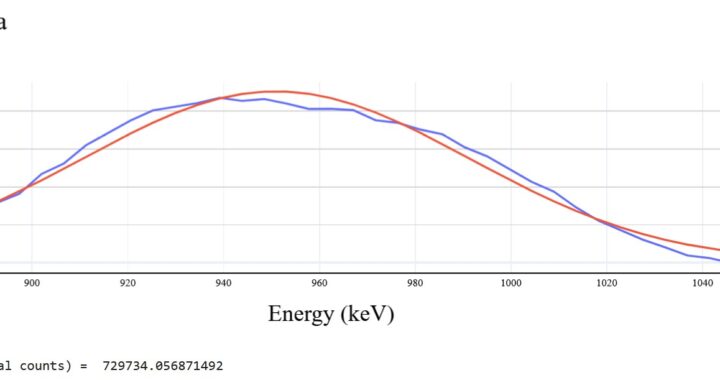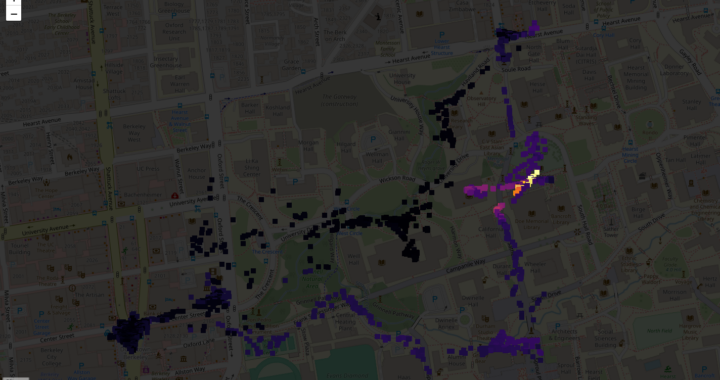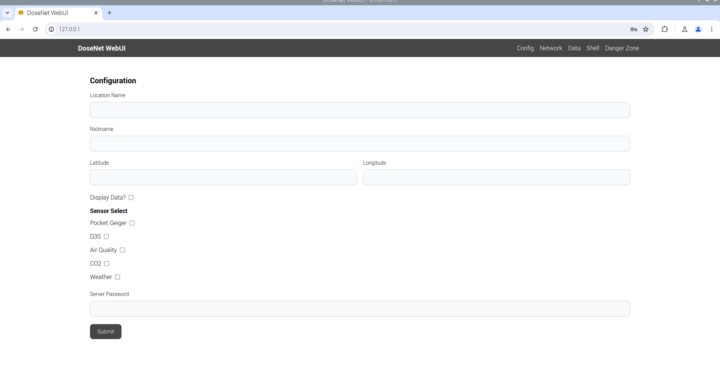
Overview
Last summer for his summer work partnered with Radwatch/Dosenet at UC Berkeley, high school senior Ethan Fang performed a data analysis and compiled a report “On the Radiation Released by Chernobyl Forest Fires and by the Recent California Wildfires” utilizing spectroscopic data collected with Dosenet sensors. Ethan’s research particularly focused on the relationship between air quality and radiation, engaging a hypothesis that presumed a level of irradiation for firefighters in California based on radiation exposure data collected for firefighters in Chernobyl.
2020 Chernobyl Forest Fires
In April of 2020, the forest surrounding the Chernobyl nuclear reactor sparked into a raging wildfire. Over 115,000 acres burned in 10 days, and the smoke traveled to countries as far as Norway [5]. In addition to the declining air quality, these countries also observed increased radiation in their sensors. What was the source of the radiation?

Aerial View of April Chernobyl Wildfires, via Emergency Situation Ministry, AP
Arboreal Radiation Containment
A nuclear power plant in Chernobyl exploded in 1986, more than three decades before the fire, sending 300 times the amount of radiation released from Hiroshima into the atmosphere [10]. While the bulk of the lighter radioactive isotopes were blown into neighboring regions immediately following the accident, most of the radiation was contained in the dense forest surrounding the reactor. Many of the heavier radioactive isotopes left behind in the disaster such as cesium-137, plutonium-238 and 239, and strontium-90 have properties similar to those of potassium and calcium, elements essential to cell growth [3]. These properties caused the isotopes to get absorbed into trees and plants. In 2003, the Ukrainian radiologist Vasyl Yoschenko conducted a study on radioisotopes behavior during forest fires [3]. He found that the isotope content in the air increased as they were released in “blasts of smoke and heat.” The article wrote, “in just one hour, the firefighters could have been exposed to more than triple the annual radiation limit for Chernobyl’s nuclear workers.”
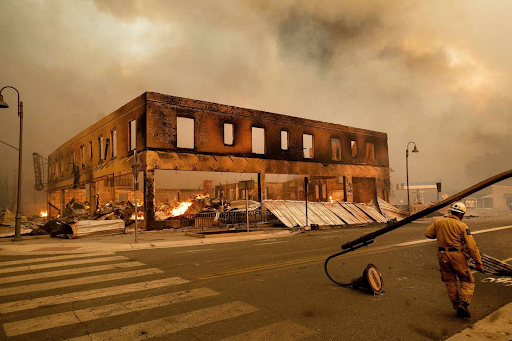
Photo of Greenville, one of the many towns devastated by the Dixie Fire Noah Berger, AP
West Coast Wildfires
West Coast wildfires have become an annual event in the United States. In the last few years, the Paradise, Kincade, and Carr fires have ravaged towns, forests, and wildlife. This year, the Dixie Fire in Butte County has charred nearly 1,000,000 [6] acres. Smoke from this fire has traveled all over the United States to cities as far as Boston and New York.
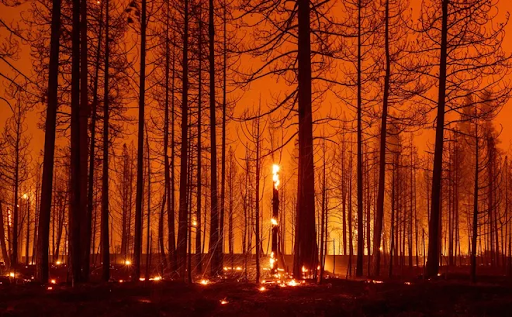
Photo of Dixie Forest Fire, Josh Edelson, Getty Images
Radiation from California Forest Fires
Have the recent forest fires been releasing radiation into the atmosphere like they did in Chernobyl?
The United States hasn’t experienced a nuclear disaster like Chernobyl, but other sources may have caused absorption into West Coast forests. The United States Nuclear Testing Program tested more than 1,000 bombs during the Cold War [8], releasing radioisotopes into the atmosphere. Besides “man-made” radioisotopes caused by nuclear fission, there are also naturally occurring isotopes such as potassium-40, carbon-14, and uranium-238 [11].
The Dosenet group at UC Berkeley makes use of two types of radiation sensors, a 1 square cm silicon semiconductor chip (the Pocket Geiger), and a 1 cubic cm cesium iodide (CsI) scintillator. The CsI scintillator is more sensitive to radiation and has the capability to extract energy information from the detected radiation, allowing one to perform spectroscopy with the data. The more basic radiation detector, the pocket geiger, outputs a single count for each detection of a gamma ray or beta decay, while the CsI detector generates light at intensities directly related to the energy absorbed from detected gamma radiation that can be considered as single interaction counts (Geiger behavior), or evaluated as a function of energy.
Using data collected from Dosenet’s sensors, we began by averaging hourly Pocket Geiger counts, cesium iodide spectrometer counts, and PM2.5 air particle detector data for specific time frames during major fires. Then, we calculated the least squares regression line (LSRL) data to examine the effect between the explanatory (air quality) and response (radiation count) variables. We observed a consistent pattern in the 3 locations where we were able to obtain sufficient data.
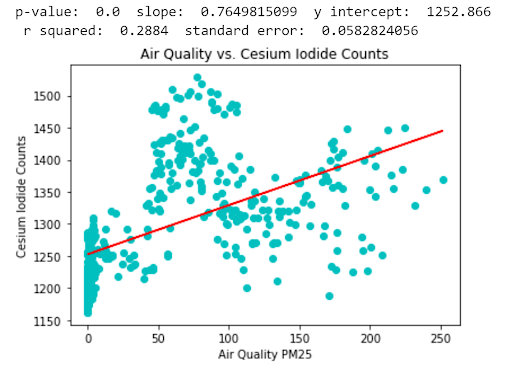
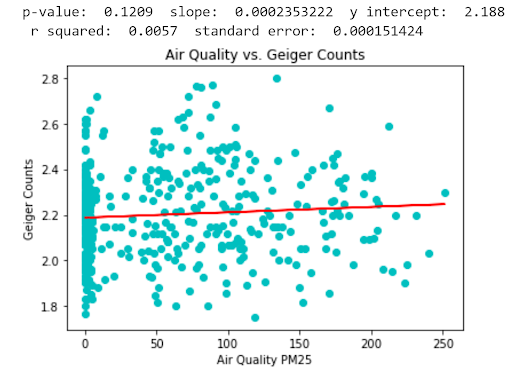
While the air quality and Geiger counts graph showed no association due to its lower sensitivity relative to the Csl detector, there was a positive correlation between air quality and cesium iodide counts in the atmosphere. The result led us to conclude that the trees and ecosystems burned by the wildfires contain radioactive material that is released as particulate matter in smoke. Whether the isotopes are artificially created or naturally occurring can be determined with further research and isotope identification using spectroscopy. (See “Future Research”)
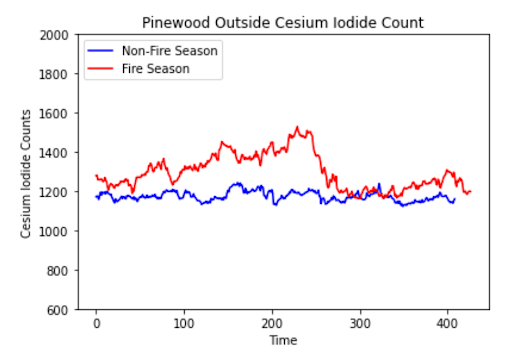
Graphs comparing air quality and cesium iodide
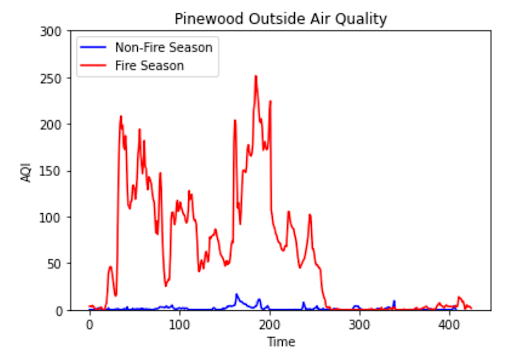
count during Paradise Fire and “Non-Fire” season
Potential Health Risks
Does the radiation released by the California forest fires pose a health risk to humans?
The firefighters fighting the April Chernobyl wildfires last year were exposed to very low levels of radiation in the air – 0.311 mSv [5]. This is within the safety guideline of 20 mSv [12] radiation exposure per year deemed low-risk to humans. If the Chernobyl firefighters experienced unhazardous levels in the forest, where an abundance of “man-made” isotopes exist, the West Coast wildfires should not pose additional health risk to humans. In addition, our observed radiation was within naturally occurring background radiation around the world. Whereas background radiation around the US can vary by factors of 100-200%, we only observed total variations in our data of around 20-25%. Since our data did not surpass naturally occurring background radiation levels around the world, there should be no cause for concern for one’s health from radiation released from these fires.
Future Research
A potential extension to our research would be to identify the radioisotopes in the air using the spectroscopic data available from the DoseNet CsI detectors, or the more precise Spectra Continuous Specialization Localization (CSL) sensor data. Most radioisotopes emit gamma radiation, so examining peaks in the energy spectrum data can help identify the exact isotope and whether it came from an artificial or natural source.
Acknowledgements
We thank Dr. Ali Hanks of the UC Berkeley Radiation Department for her guidance during our research as well as Dani Solakian for her assistance in editing our article.
References
- “CDC Radiation Emergencies.” Centers for Disease Control and Prevention, Centers for Disease Control and Prevention, 4 Apr. 2018, www.cdc.gov/nceh/radiation/emergencies/isotopes/cesium.htm.
- Fagone, Jason, and Cynthia Dizikes. “A Helicopter Scan for Radioactivity at SF’s Former Bases Had Limited Value. the City Relied on It Anyway.” San Francisco Chronicle, San Francisco Chronicle, 1 Sept. 2020, www.sfchronicle.com/bayarea/article/Extremely-Unlikely-That-They-Will-Find-15519861.php.
- Little, Jane Braxton. “Forest Fires Are Setting Chernobyl’s Radiation Free.” The Atlantic, Atlantic Media Company, 20 Aug. 2020, www.theatlantic.com/science/archive/2020/08/chernobyl-fires/615067/.
- “Nevada Test Site.” Atomic Heritage Foundation, www.atomicheritage.org/location/nevada-test-site#:~:text=On%20January%2027%2C%201951%2C%20nuclear,atmospheric%2C%20and%20921%20were%20underground.
- “Are Forest Fires UNLOCKING Radiation in Chernobyl?” BBC News, BBC, www.bbc.com/news/av/world-europe-55404164.
- Staff, CBS13. “Dixie Fire Burns More Than 960K Acres.” CBS Sacramento, CBS Sacramento, 12 Sept. 2021, sacramento.cbslocal.com/2021/09/12/dixie-fire-lassen-plumas-updates/.
- “Radiation Studies – Cdc: Terrestrial Radiation.” Centers for Disease Control and Prevention, Centers for Disease Control and Prevention, 7 Dec. 2015, www.cdc.gov/nceh/radiation/terrestrial.html#:~:text=Naturally%20occurring%20radioactive%20elements%20such,a%20threat%20than%20inhaling%20it.
- “The United States’ Nuclear Testing Programme.” The United States’ Nuclear Testing Programme: CTBTO Preparatory Commission, www.ctbto.org/nuclear-testing/the-effects-of-nuclear-testing/the-united-states-nuclear-testing-programme/#:~:text=The%20United%20States%20conducted%201%2C032,%2C%20Mississippi%2C%20and%20New%20Mexico.
- Varenikova, Maria. “Chernobyl Wildfires Reignite, Stirring up Radiation.” The New York Times, The New York Times, 11 Apr. 2020, www.nytimes.com/2020/04/11/world/europe/chernobyl-wildfire.html.
- “Chernobyl Disaster.” Chernobyl | Chernobyl Accident | Chernobyl Disaster – World Nuclear Association, world-nuclear.org/information-library/safety-and-security/safety-of-plants/chernobyl-accident.aspx.
- “Naturally Occurring Radioactive Materials.” Naturally Occurring Radioactive Materials NORM – World Nuclear Association, world-nuclear.org/information-library/safety-and-security/radiation-and-health/naturally-occurring-radioactive-materials-norm.aspx.
- Keith Baverstock Docent in the Department of Environmental Science. “Explainer: How Much Radiation Is Harmful to Health?” The Conversation, 2 Aug. 2021, theconversation.com/explainer-how-much-radiation-is-harmful-to-health-17906.


